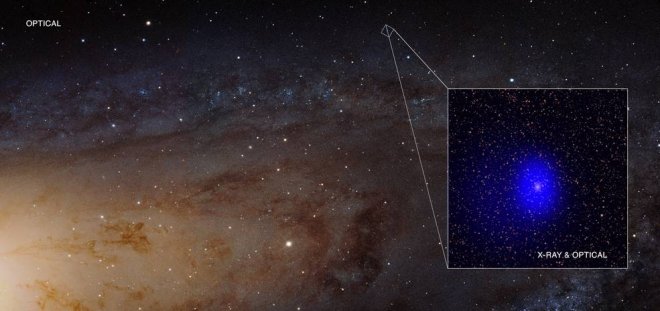
NASA's Chandra X-ray Observatory has accidentally photographed tightly coupled pair of supermassive black holes ever seen. The unexpected recent image was taken by the X-ray Observatory while it was studying the Andromeda galaxy.
The supermassive black hole, also known as LGGS J004527.30+413254.3 (J0045+41 for short) was seen in optical and X-ray images of Andromeda. It was pictured using the Chandra X-ray Observatory and also found in optical data from the ground-based telescope in Gemini-North, Hawaii and the Caltech's Palomar Transient Factory in California.
The scientists had believed that the J0045+41 was within the M31 galaxy. But the recent images proved that the black hole pair was actually located at a much greater distance from the galaxy. According to the new data, the spiral galaxy M31 is located at a distance of 2.5 million light-years from the Earth while the black hole pair has been located at around 2.6 billion light years distance.
Trevor DornWallenstein of the University of Washington who led the study said, "We were looking for a special type of star in M31 and thought we have found one. We were surprised and excited to find something far stranger!"
The researchers found that the two giant black holes which are around 200 million times the mass of Earth's Sun were indeed orbiting each other at a close distance. Emily Levesque of the University of Washington said, "This is the first time such strong evidence has been found for a pair of orbiting giant black holes."
Astronomers had previously believed it to be a pair of stars that orbit each other once in every 80 days.
Studies based on Chandra's X-ray images showed that the J0045+41 would be either a binary system in Andromeda galaxy containing a neutron star or black hole that pulls materials from its companion or a rapidly growing supermassive black hole in a distant system.
John Ruan of the University of Washington said, "We're unable to pinpoint exactly how much mass each of these black holes contains. Depending on that, we think this pair will collide and merge into one black hole in as little as 350 years or as much as 360,000 years."
Dorn-Wallenstein said, "Supermassive black hole mergers occur in slow motion compared to stellar-mass black holes. The much slower changes in the gravitational waves from a system like J0045+41 can be best detected by a different type of gravitational wave facility called a Pulsar Timing Array."
The researchers studied spectrums from the black holes using the Gemini-North telescope and estimated the distance of the first black hole from the Earth. Later they understood that the pair black hole was orbiting each other in 80 days and 320 days respectively.
The astronomers found that the black holes were separated by only a few hundred times the distance of the Earth and Sun. This has been considered as a very close distance as the nearest star to the Earth's Sun is about four light year distance from it.
They found that the black hole pairs were drawn close together by two merged galaxies. The black hole pairs emit gravitational waves as they orbit each other.
However, the LIGO and Virgo telescopes failed to detect the gravitational waves from the orbiting black holes. The LIGO and Virgo had recently detected gravitational waves from two merging black holes which were no more than 60 Suns and from the merger of two neutron stars.









